Parts 1-3 on January 5-6, 2025 by Dindo Malonzo
Parts 4-5 on January 7-8, 2025 by Russel Orodio
There is a lot of mystique surrounding PICOP as a birding area. Birders have been visiting the old logging concession for more than 30 years hoping to glimpse many of the Philippines’ rarest and most beautiful birds. However, PICOP’s history has been marred by the constant sound of chainsaws and security issues. These days, the remaining good forests are still some of the best for lowland Mindanao species, but worry is always in the back of the mind that PICOP’s days as a birding site are numbered.
Part I. Prep
PICOP is a collection of sites near Bislig City, stretching between Surigao del Sur and Agusan del Sur. In the late 50’s to the early 60’s, it was a huge logging concession awarded to the Paper Industries Corporation of the Philippines (PICOP.) In the late 80’s, PICOP began to decline as a company and today is essentially dead. This has led to the forest becoming a free-for-all for informal settlers, illegal loggers, poachers, and rebel elements with little in the way of government enforcement. Despite all this, the remaining pockets of good forest are still frequented by birders, though the community seems resigned to the eventual disappearance of this amazing site.
I started planning the trip as part of an extended holiday stay Mindanao. Being based near Davao at that time, I had access to most of the high-altitude forest sites for Mindanao highland endemics, but PICOP is still the best site for the lowland species. I started asking around earlier last year for people to join (and split costs with) and was joined by a handful of the newer club birders: Patcha Pangatungan, Russel Orodio, Edgar Yap, and Jolly Sulapas. Since Jolly and I were already in Mindanao, the other three would meet us in Bislig on January 4th. They would arrive with enough time to squeeze in a quick stop at the Old Airport to start off the trip with a few species.
I had previously contacted the legendary PICOP guide, Kuya Zardo, and Ma’am Ever of the local Tourism Office to make arrangements for our group. They graciously invited us to dinner on the eve of our trip to get our and the club’s opinion on their planned bird fair for Bislig and nearby areas. They also had Ma’am Ever and Kuya EhNoy (a local guide) come with us since they were being trained in bird guiding by Zardo. They would meet us at the Paper Country Inn at 4am and our three-day birding trip would commence.
Part II. Day 1
We woke up when it was still dark and early, planning to do some owling before starting on Road 4. Along the way, we learned that Kuya Zardo had come straight from a tour in Mt. Kitanglad with hardly any sleep! The man is a machine.
Arriving at the owling site, we started working the speakers for the elusive owls. Kuya Zardo was telling us about excellent sightings of Giant Scops and Everett’s Scops Owls in the area previously. Alas, we only managed to hear Chocolate Boobook and Rufous-lored Kingfisher, while seeing Great-Eared Nightjar and Asian Koel in flight.
On to Road 4 for some early morning birding. Stepping out of the jeepney, we were immediately greeted by the resonant calls of Pink-bellied Imperial Pigeons. Known to perch high up in the canopy, we didn’t look too hard for them for the moment. Walking down a hundred meters from where we parked, we chanced upon a thicket with a small mixed flock. We saw a flash of indigo in the dark interior and we managed brief but good views of Short-Crested Monarch early on, a notoriously hard bird to see elsewhere, along with some tailorbirds and flowerpeckers.
We turned right into a small trail where, a few meters in, we flushed a bird from the ground with a very distinct wing flap sound. Internally, I was thinking that might have been a Mindanao Bleeding-heart, but it might have just been wishful thinking. The trail led to a large clearing surrounded by tall trees. Immediately after our entry, a family of Southern Rufous Hornbills flew in and perched for a good while to the delight of the group.
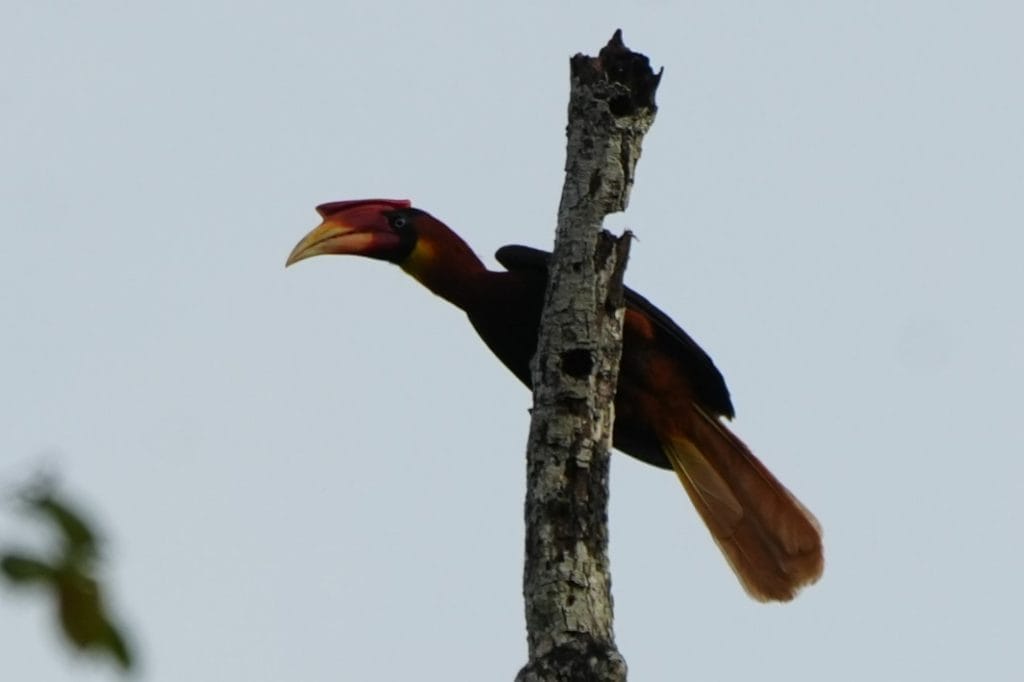
We stayed in that clearing for an hour or so, managing to spot Short-tailed Drongo, Yellowish Bulbul, Yellow-wattled Bulbul, White-bellied Woodpecker, and Philippine Green Pigeon. Back in the trail, among the Olive-capped and Orange-bellied Flowerpeckers, we manager to call in two Striated Wren-Babblers for some good photos.
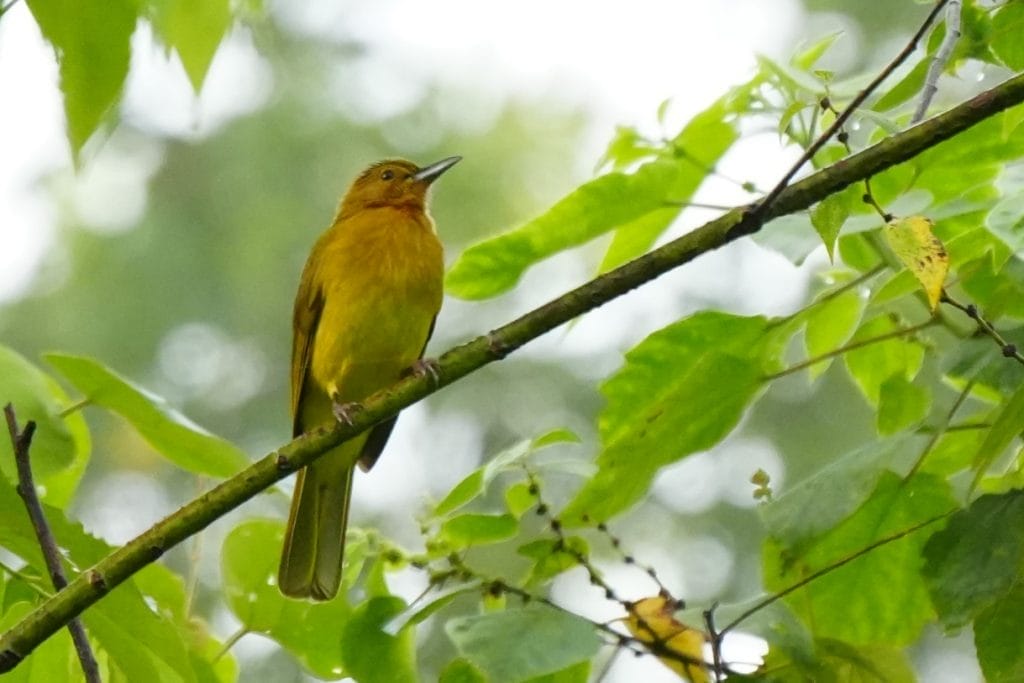
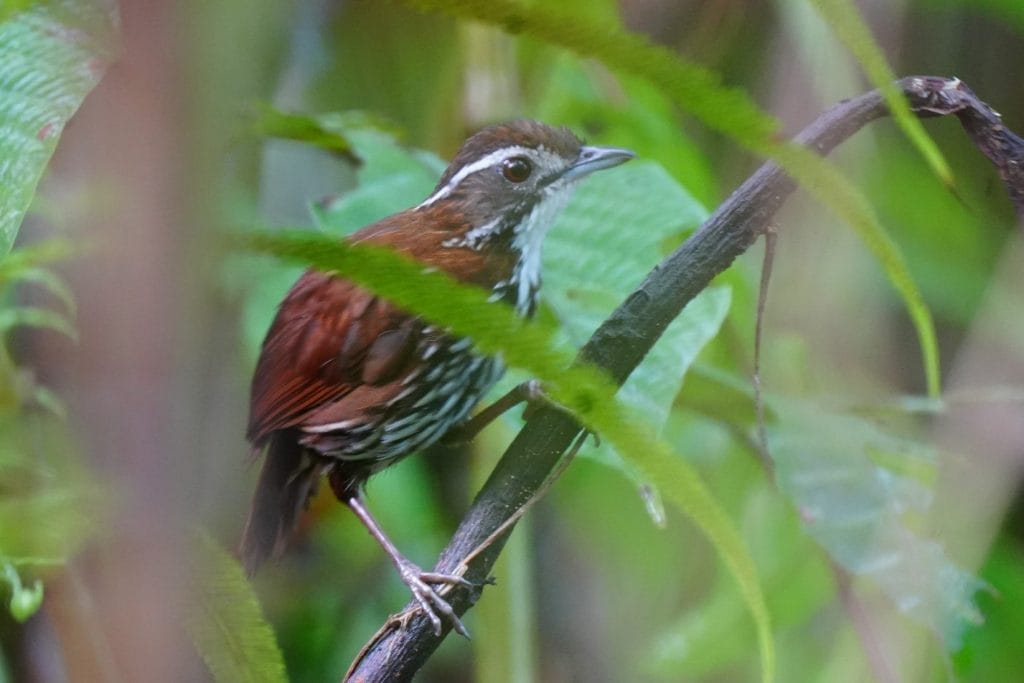
Back on the main road, after a brief stop at the jeepney, Kuya EhNoy spotted the Pink-bellied Imperial Pigeon on a distant perch. We spent a while trying to get it on the scope, since this was a rare sighting. Sadly, the guides were telling us that the Imperial Pigeons and all the large birds here are prime targets for hunting for meat by the local settlers. Walking further down the road, we heard the tell-tale racket (heh) of the Blue-crowned Racquet-tail and sure enough two flew overhead. Along the way, we got to see several Mindanao Hornbills and hear the Writhed Hornbill (unfortunately, they wouldn’t appear this trip.)
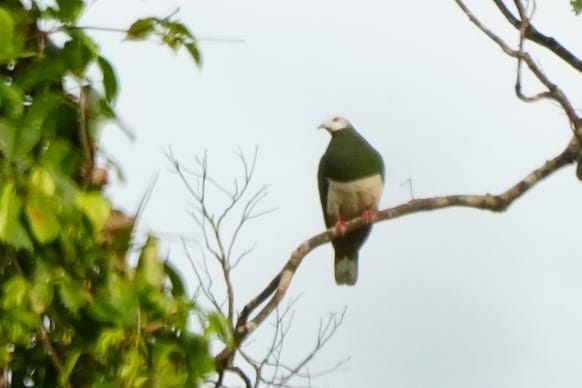
We then arrived at a dry creek bed with a good patch of forest surrounding it. Here we saw a big mixed flock up in the canopy, getting good views of Mindanao Blue Fantail and glimpses of the other birds. We decided to move on for now and proceeded to a cleared area with coconuts and some houses. Here, the forest edge and mixed environment allowed for more diverse species and we managed to see Handsome, Metallic-winged, and Purple-throated Sunbirds, Mindanao Pygmy Babblers, and more Mindanao Hornbills.

We then went back to the jeepney for a breather since the heat was starting to intensify. After the break, we went into a second trail where we encountered an excellent mixed flock of Rusty-crowned Babbler, Southern Rufous Paradise Flycatcher, Short-crested Monarch, Philippine Drongo-Cuckoo, Yellow-bellied Whistler, and Short-tailed Drongo. On the way back, we saw a male Mindanao Hornbill perched quite low. Just before lunch, we tried for Azure-breasted Pitta but only managed to add an Orange-tufted Spiderhunter to our list.


At lunch, it was distressing to see men with chainsaws casually walking around the community. I had asked Kuya Zardo earlier about some hills I saw in the distance that still had good forest, and he said that they all had men who claimed “ownership” over them. I asked if that meant they are to be clear-cut, and he said yes. I hadn’t expected the realities of PICOP to be so blatant and unapologetic, yet there they were.
After lunch back at the creek bed, we had a more productive time and we managed clear views of Philippine Leafbird, Scarlet Minivets, and Violet Cuckoo. As we were leaving, we heard a distinct clear three-toned call. Kuya Zardo and I looked at each other and we both exclaimed “Celestial!” The top target of the trip and crown jewel of PICOP, the Celestial Monarch, had entered the chat. We would work for a while to try and call it in, but it didn’t show that day. Unsuccessful but satisfied, we then make our way back to the jeepney and on to the Dirty Pond.
At the Dirty Pond, the main target was the Southern Silvery Kingfisher. As we settled in to wait, we managed to add Short-billed Brown Dove, Philippine Honey Buzzard, Philippine Spinetail, and some more common urban species to our list. Alas, the Silvery was a no-show, so we moved on to somewhere near the Old Airport to try for the Grass Owl. There we added White-bellied Munia as lifers for most of the group funnily enough, as well as some common rice paddy species to our list, but no owl.
Thus concluded our first day: productive, lots of lifers, but could have been better. The next day we would be birding Road 42 where the recent sightings of the Celestial Monarch occurred. With this in mind, we retired hopeful for tomorrow and excited to see more species.

Part III. Day 2
Again, we started while it was still dark and early for a bit of owling, this time at the Reservoir. Again, we struck out on sightings but managed to hear the Giant Scops Owl and the Mindanao Boobook responding to our calls.
Moving on to Road 42, first on the agenda was the Azure-breasted Pitta, which we tried calling in right next to the parking spot. No luck on the pitta, so we started walking the road. Kuya Zardo started telling me that this area had already regenerated. I asked how is that possible what with all the logging going on, and he said that the area is further in and more regularly monitored. At least there is hope for some areas of PICOP.
While walking along the road, we encountered two mixed flocks. The first was high up in the canopy and hard to get good views of anything, though we managed to discern Mindanao Pygmy Babblers and Brown Tit-babblers. The second had much better views of Philippine Jungle Flycatcher, Mindanao Blue Fantail, Philippine Leaf Warbler, and Southern Rufous Paradise Flycatcher. We tried for the Broadbill, but no luck. At the tail-end of the flock, we managed to call in a pair of Blue-capped Kingfishers for excellent photos.
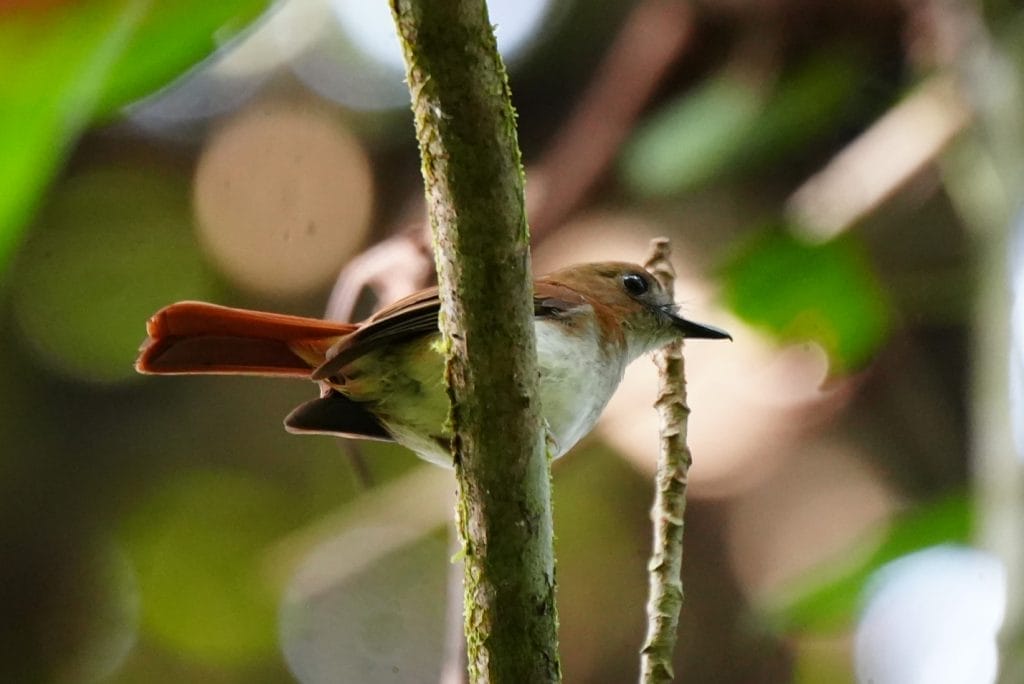

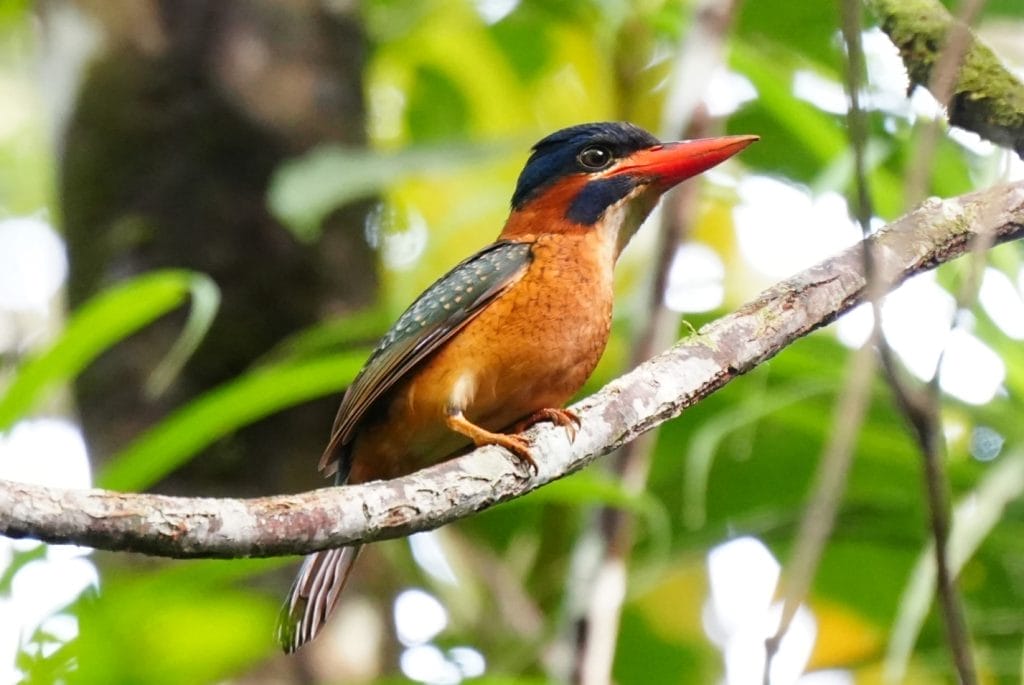
Further down the road, we would periodically hear tailorbirds. We stopped to try for the Rufous-fronted Tailorbird and managed to call in a couple, along with Metallic-winged Sunbirds in the same area. At a separate area, we worked on the White-browed (Black-headed) Tailorbird. It was stubborn and refused to perch in the open, but Edgar managed a good view of it near ground-level.
The road would turn into a trail with a bit of an incline, but nothing too strenuous. While ascending, we would hear some raptor calls and indeed a couple would fly over, too fast to properly ID. Kuya Zardo would identify just based on the calls (he would tell stories about his mentor, Tim Fisher, and how they would bird by ear.) Eventually, we reached the stretch where the Celestial Monarch sightings were consistent.
It was a flat trail segment caged in by tall trees. We settled in to wait out our target, forming a line of spotters along the trail, straining our eyes and ears for any hint. Eventually, Kuya Zardo said “Yung Celestial iyon” (“That’s the Celestial”), hearing the faintest response from down the valley. Gradually, the response got louder and louder. Kuya Zardo then said “Andito na iyong Celestial” (“The Celestial is here.”) Sure enough, a big mixed flock started flying around in front of and over us. Everyone scrambled to get bins on and identify the individuals. Among the Philippine Leafbirds, Black-bibbed Cicadabirds, Ashy Minivets, and Philippine Drongo-Cuckoo, I glimpsed a flash of bright blue and white. There it was, the Celestial Monarch…
… For maybe half a second. Hardly a satisfying view. Edgar would have the same experience as me. Ma’am Ever and Kuya EhNoy would be more fortunate and see the Celestial clearly. But no such luck for Russel and Patcha, who would miss the bird entirely. We would stay put and attempt to call in the Celestial for more views, but it would not appear again. We did manage to add Philippine Oriole to the list, but ultimately, we went back down to the jeep disappointed.

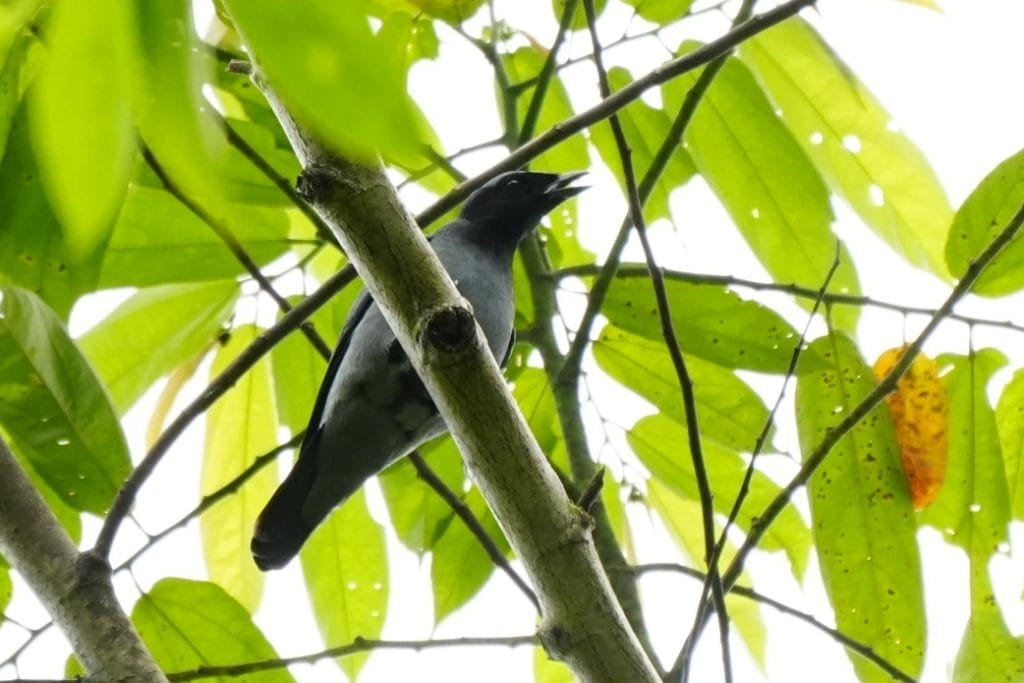
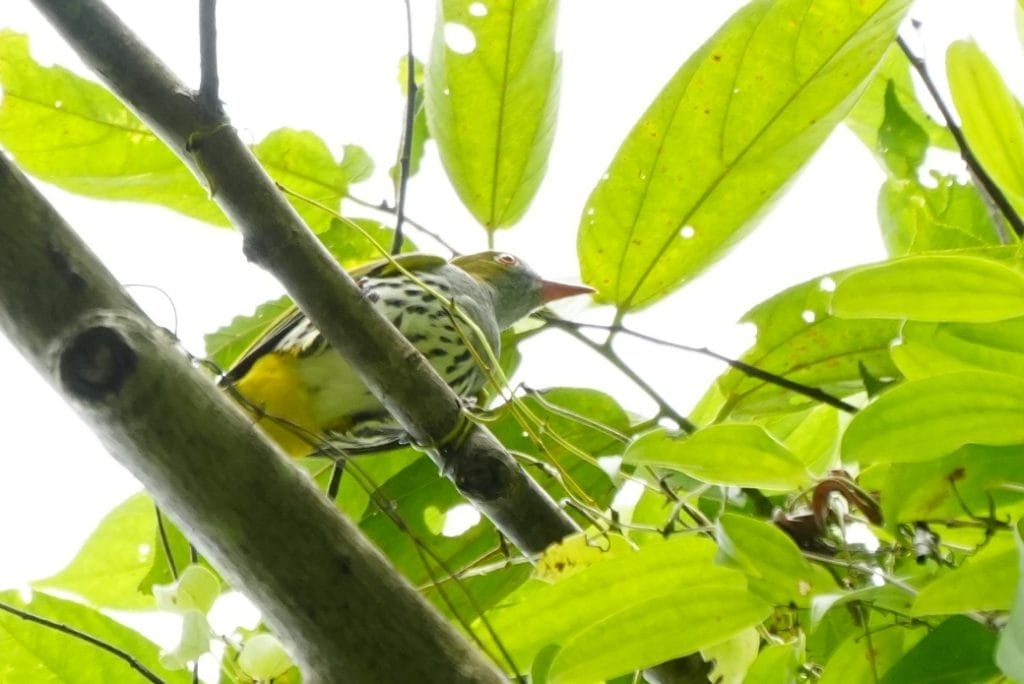
After having lunch at the parking spot (where we saw brand-new planks of wood that weren’t there when we went up), we went down into a shaded gulley trail to look for the Little Slaty Flycatcher. At the trail entrance, we saw two perched Philippine Falconets, making for a nice little photo session. In the gulley, we settled in and worked on the Little Slaty. After quite a long time without any hints, Kuya EhNoy spotted it perched nearby just sitting silently. Cheeky little bird. We managed to get good views of it briefly, but it was hard to spot in the undergrowth. Eventually, we returned to the jeepney and moved to the edge of the forest nearer to the city to wait for sunset. Here we added a few more common species.
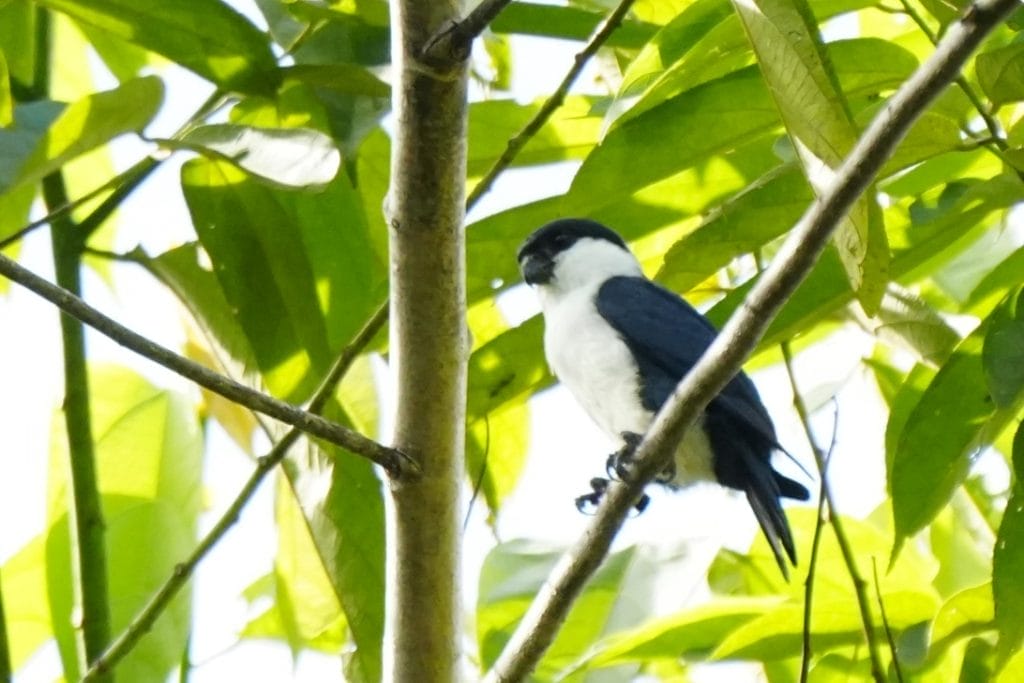
After dark, we went owling and managed to get a response from a Giant Scops Owl and Chocolate Boobook, but again they remained elusive. But finally, we were able to call in our first and only owl of the trip, the Mindanao Boobook. As a bonus, we also managed to spot a skittish but loud Philippine Frogmouth.

And so, our second day came to an end. Jolly and I were leaving that night and the group was still deliberating whether to attempt the Celestial again the next day or go to Tinuy-an Falls for a new site. I was pretty happy with our trip thus far, consoling myself with the thought that the Celestial can be seen elsewhere (*Samar foreshadowing*.) I did miss some crucial true Mindanao endemics like the Writhed Hornbill and Wattled Broadbill, which is all the more reason to come back while PICOP is still there (or look for new sites, as Kuya Zardo and I were discussing the neighboring forests and municipalities.) The group had seen almost all targets, including some hard-to-spot species and ones that are hard to get good views of. I would say it was a good haul, especially for first timers.
PICOP January 7-8, 2025
By Russel Orodio (Parts 4-5)
Part IV. Day 3 – Dirty Pond Revisited
Two members of the team, Dindo and Jolly, left the night before this part of the trip, leaving only Patcha, Ed, and me present for this leg of the journey.
As usual, we started early for an owling session near the Bislig Lowlands – Dirty Pond, hoping to spot the Everett’s Scops Owl. As Kuya Zardo played back the call of the owl, it immediately responded, filling us with excitement and shaking off our sleepiness. While eagerly sweeping our flashlights in search of it, another bird caught our attention with a single falling note—just like the one we heard last night. It was a Philippine Frogmouth. Moments after we heard its call, the Everett’s Scops Owl fell silent and seemed to have been driven away.
The frogmouth then decided to reveal itself, its call growing closer. We were elated to get a much better view than we had the night before.

We also heard the Giant Scops Owl, Mindanao Boobook, and some Great-eared Nightjar just soaring above us before the sun rose. Our team then embarked to Road 4 again to continue our morning birding.
Part V. Day 3 – Road 4 Revisited
Since we were planning to split our time into two birding sites, we ambitiously focused and attempted seeing the rare endemics such as Mindanao Wattled Broadbill, Celestial Monarch, Writhed Hornbill, and Azure-Breasted Pitta.
Our team immediately headed out to the small trail to the right of the main road leading us to the open area surrounded by tall trees. We were greeted with a mixed flock including sunbirds, flowerpeckers, starlings, bulbuls, tailorbirds, and even a Short-Crested Monarch was seen from afar.
For some time, we heard a loud and raspy “grrrrr” sound in front of us and saw a bird with a long-curved bill. It was a Naked-faced Spiderhunter, a personal lifer for me! It gave us good views while it was busy feeding on a flower of a Bangkal tree.
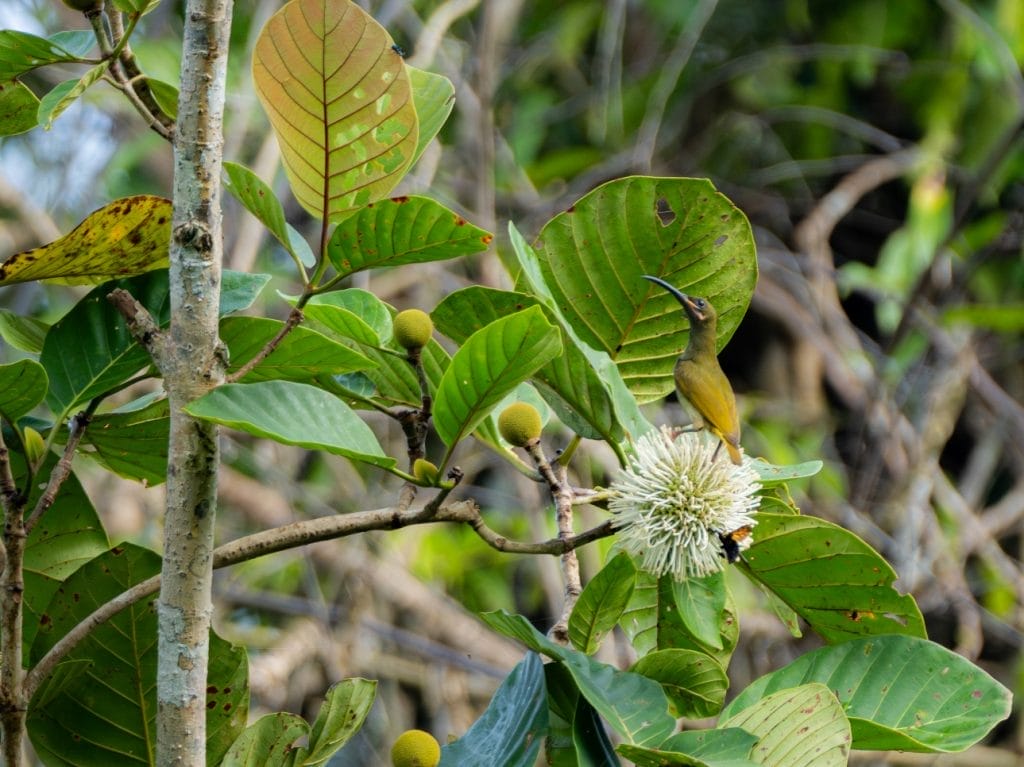
Time was ticking fast, so we decided to move to another spot—just across the main road—to search for our targets. For a moment, we heard a faint sound surrounding us, and we quickly recognized it as the call of the Azure-Breasted Pitta (Steere’s Pitta)! We used playback in hopes of drawing it out, and after patiently waiting, a bird suddenly swooped past us, prompting a chase. We ran down the trail, and with Kuya Ehnoy’s help, we finally spotted the Steere’s Pitta perched on the far side of the forest.

The real challenge was that it only offered a single vantage point where we could see it clearly, so we took turns appreciating it and capturing photos. Finally, another incredible addition to our life list! Unfortunately, some targets were no-show. Well, that’s birding for you! Better luck next time!
Part VI. Day 3 – Tinuy-An Falls
We were running late for some birding since it was already afternoon when we arrived at Tinuy-An Falls. Aside from birding, anticipation filled my curiosity as I was excited to see the widest waterfalls in the Philippines. Water from Tinuy-An falls flows from three levels, and our target bird resides in the upper level/tier, and that is the Southern-Silvery Kingfisher.
As we made our way up the trail to the upper level, it was eerily quiet and not very birdy—perhaps the birds had already had their fill. Arriving at the upper level, a broad stream of pristine water welcomed us that boosted our moods and anticipation of seeing our target bird.
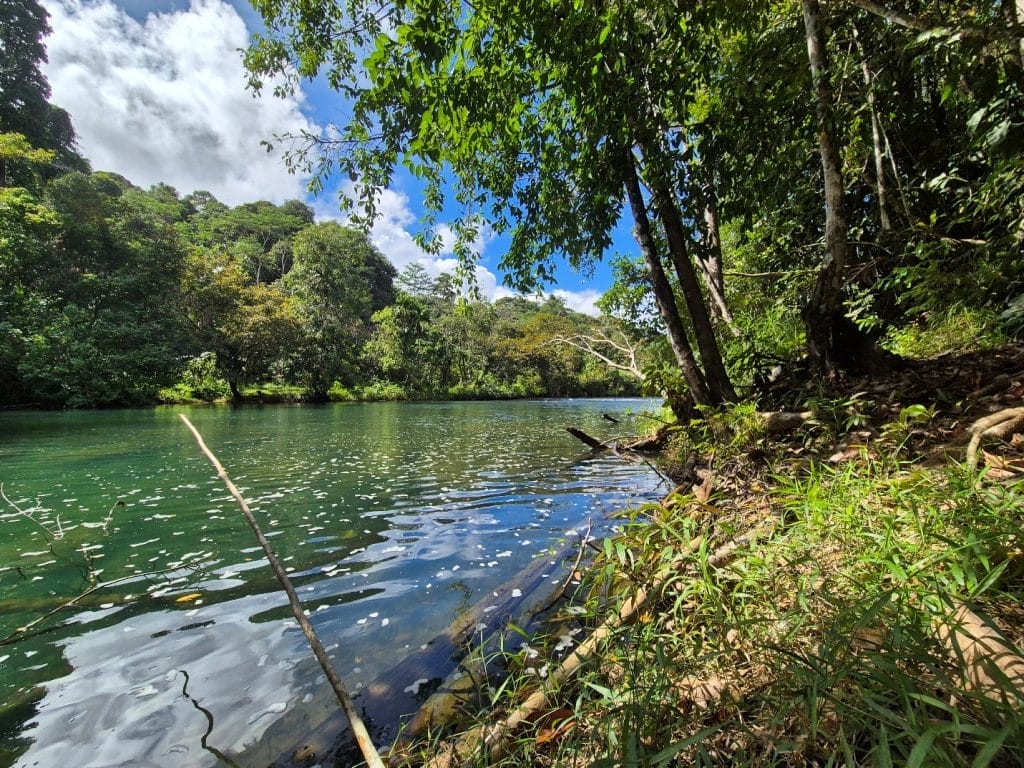
We waited for hours for the Southern Silvery Kingfisher to appear, enjoying the view and resting to ease our weariness, but luck wasn’t on our side this time. Still, the trip was worth it just to witness the grandeur of Tinuy-An Falls. Ahhh, must be nice living in the province!

On our way back to our accommodation, Patcha and I decided to return to the falls early the next morning to spot some endemic birds typically found there, while Ed planned to go birding at PICOP Airstrip instead.
We ended the day with a sumptuous dinner at a nearby restaurant and bid farewell to Kuya Zardo, Kuya Ehnoy, and Ate Ever. You guys are the best—thank you for your warm hospitality!
Part VII. Day 4 – Tinuy-An Falls Revisited
We got plenty of rest this time since we weren’t doing owling. Patcha and I decided to take a DIY trip to Tinuy-An Falls and hired a tricycle driver recommended by Kuya Ehnoy. It was foggy when we arrived at the Tinuy-An Falls Arc/entrance right at 6 AM. We didn’t have any specific target birds in mind, except for the elusive kingfisher on the stream.
Moments after lingering near the arc, we heard woodpeckers pecking on trees. To our surprise, they were Buff-Spotted Flamebacks—another lifer! Patcha and I were overjoyed since we hadn’t expected to see them. We spotted about three, and they gave us plenty of time to admire them as they flew from one tree to another.

Since our trip was time-limited, we proceeded once again to the broad stream in an attempt to spot the Southern Silvery Kingfisher. While making our way along the trail, we noticed a couple of birds swooping overhead before perching above us—Yellow-Breasted Fruit Doves, another lifer! They gave us great views before flying off after feeding on a nearby fruiting tree.
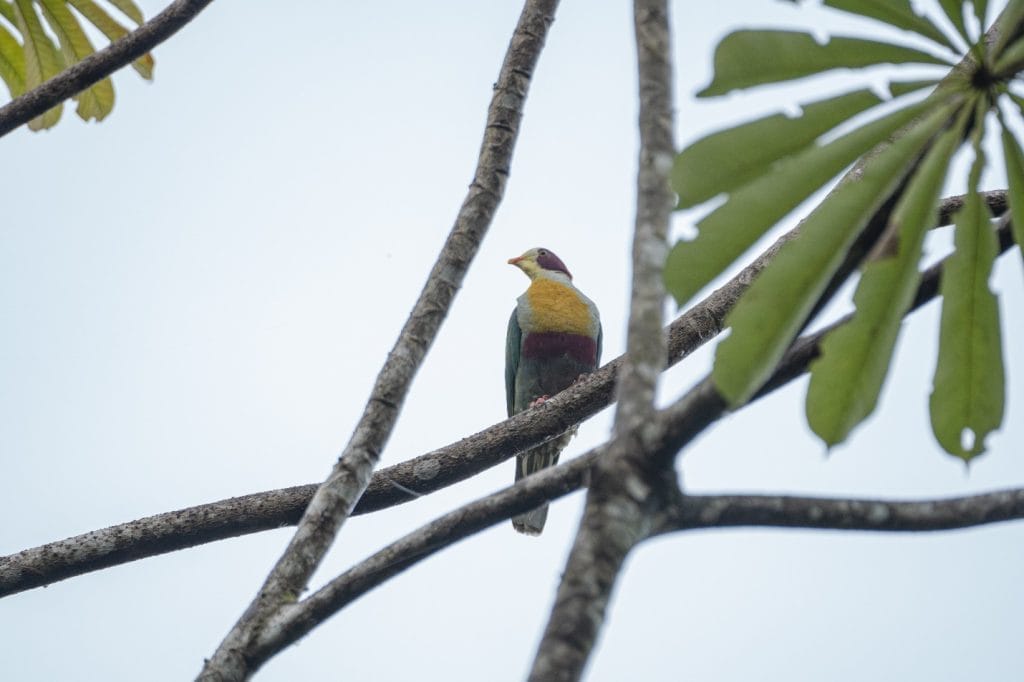
When we arrived at the upper level of the falls, we did the same thing as yesterday—wait. Unfortunately, the kingfisher continued to elude us. Still, it was a fulfilling trip, as we were able to add new species to our life list.
From this experience, I realized that the best moments often come when you least expect them. Just like birding, and that is the beauty of it!
